Earned Value Management (EVM) Background
The concept of earned value management became a fundamental approach to program management (EVM project management) in 1966 when the United States Air Force mandated earned value (USAF EVMS) in conjunction with the other planning and controlling requirements on Air Force programs. The requirement was entitled, the Cost/Schedule Planning Control Specification (C/SPCS). Over the decades, the concept and its requirements have remained basically unchanged. It has had periodic updates to its title: Cost/Schedule Control System Criteria (C/SCSC), Earned Value Management Systems Criteria (EVMSC), and the current 32 guidelines in the EIA-748 Standard for Earned Value Management Systems (EVMS). The EVM concept presented in these requirements is a sound management approach, that once incorporated on any type of program, whether research and development, construction, production, etc. provides all levels of management with early visibility into cost and schedule problems. Earned value management is now used on programs world-wide. Primary EVM users include the United States, Europe, England, Canada, Australia, China, and Japan. It is a requirement of many U.S. Government agencies, including the Department of Defense (DoD), the National Aeronautics and Space Administration (NASA), the Department of Energy (DOE), the Intelligence Community, the Department of Homeland Security (DHS), the Federal Aviation Administration (FAA) and Department of Transportation (DOT), Health and Human Services (HHS), and others.
What is earned value management (EVM)? The basic concept of EVM is more than a unique project management process or technique. It is an umbrella term for 32 guidelines that define a set of requirements that a contractor’s management system must meet. The objectives of an EVMS are to:
- Relate time phased budgets to specific contract tasks and/or statements of work.
- Provide the basis to capture work progress assessments against the baseline plan.
- Relate technical, schedule, and cost performance.
- Provide valid, timely, and auditable data/information for proactive project management analysis and action.
- Supply managers with a practical level of summarization for effective decision making.
Once the contractor’s EVM System is designed and implemented on a project, there are significant benefits to the contractor and to the customer. Contractor benefits include increased visibility and control to quickly and proactively respond to issues which makes it easier to meet project schedule, cost, analysis, and technical objectives. Customer benefits include confidence in the contractor’s ability to manage the project, identify problems early, and provide objective, rather than subjective, contract cost analysis and schedule status. Earned value management does introduce a few new terms. Contractors’ internal systems must be able to provide:
- Budgeted cost for work scheduled (BCWS), sometimes called the planned value.
- Budgeted cost for work performed (BCWP) or earned value.
- Actual cost of work performed (ACWP).
- Budget at completion (BAC).
- Estimate at completion (EAC) which is comprised of the cumulative to date actual cost of work performed plus the estimate to complete the remaining work.
- Cost variance (CV) which is calculated as BCWP minus ACWP. A result greater than 0 is favorable (an underrun), a result less than 0 is unfavorable (an overrun).
- Schedule variance (SV) which is calculated as BCWP minus BCWS. A result greater than 0 is favorable (ahead of schedule), a result less than 0 is unfavorable (behind schedule).
- Variance at completion (VAC) which is calculated as BAC minus EAC. A result greater than 0 is favorable, a result less than 0 is unfavorable.
The Analysis and Management Reports section below illustrates using the EVM analysis variances to track trends over time as a management tool for EVM.
About the 32 Guidelines
The 32 guidelines in the EIA-748 Standard for EVMS are divided into five sections which are discussed below.
- Organization
- Planning, Scheduling and Budgeting
- Accounting Considerations
- EVMS Analysis and EVMS Management Reports
- Revisions and Data Maintenance
Organization
This first section includes 5 guidelines that focus on organizing the work. One of the most fundamental is that the contractor must establish a work breakdown structure (WBS) extended down to a level that describes the tasks that will be performed as well as their relationship to product deliverables. Also critical is the organization breakdown structure (OBS) that identifies who is responsible for the work effort defined in the WBS. It is at this level where the WBS (what) and OBS (who) intersect that defines a control account, a key management control point. The person responsible for the work effort (scope, schedule, and budget) is the control account manager (CAM). This is the foundation for ensuring the contractor’s planning, scheduling, budgeting, work authorization, and cost accumulation processes are fully integrated — for the EVMS contractor‘s compliance. Establishing the control accounts is illustrated below.
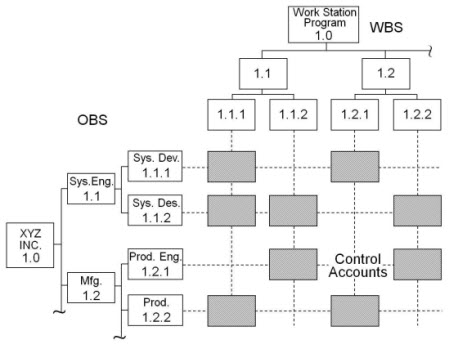
Intersection of the WBS and OBS establishes the control accounts
Planning, Scheduling, and Budgeting
The second section includes 10 guidelines that cover the basic requirements for planning, scheduling, and establishing the time phased budgets for the tasks. The integrated master schedule is the project’s road map to meet contract objectives. This schedule must be resource loaded to determine the budget for the work as scheduled. The resource loaded schedule is the basis for the monthly budget, or BCWS, for each task and thus the project. This time phased budget is the performance measurement baseline (PMB). The total budget for each task, control account, or the entire project is defined as the budget at complete (BAC). Because most projects are initiated with some level of uncertainty; i.e. risk, project managers typically set aside a portion of the total project value as a management reserve (MR). MR added to the BAC equals the total project budgeted value, defined as the contract budget base (CBB). This is illustrated below.
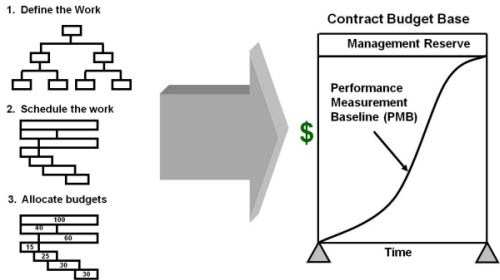
Establishing the baseline – an Iterative, three step process | EVM Analysis
All of the budgets on any project should be logged for successful baseline control. Occasionally contracted tasks may be temporarily held in abeyance, not yet authorized to a manager. When the project manager has yet to assign tasks and budgets to the CAMs, such as an authorized, not yet negotiated additional work, the task and its budget can be retained in undistributed budget (UB). These budget assignments, the WBS, and the functional organizational identity of the managers can be captured in a matrix as illustrated below.
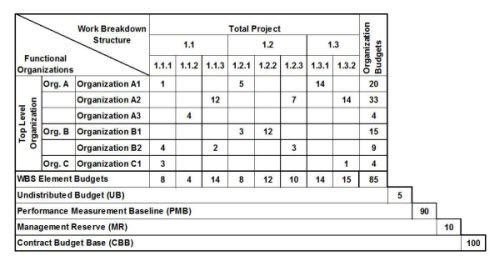
EVM Budget summary matrix
A very important aspect of the planning and budgeting process is to determine how BCWP will be assessed. This determination begins with classifying work tasks as one of three types: discrete, apportioned effort, or level of effort (LOE). From this initial classification, for each discrete work effort work package, the CAM selects an earned value technique such as milestones, 50/50, 0/100, or percent complete. It must be stressed that work only begins when there is formal work authorization to proceed. This requirement is a disciplined approach to clearly define work, schedule, and budget before work commences and actual costs begin to accrue. How can someone be expected to manage the work effort when it is unclear what is to be done? The ad-hoc approach to managing, “Give me a charge number and I’ll tell you when I’m done with whatever I think I am supposed to do” does not work. The principles of EVM are quite clear in this regard.
Accounting Considerations
This section is a very straightforward, long standing project management set of 6 guidelines for capturing actual costs (ACWP) expended for project work effort. Actual costs must be captured in a manner consistent with the way work is planned and budgeted. The section outlines the need to select the appropriate time to schedule an important project resource, material, and to accrue performance data correctly. The section also stipulates a common sense practice to accrue the costs for the material in the same month as the BCWP was taken (earned) to avoid a very misleading cost variance, also known as “booking lag.”
Analysis and Management Reports
The fourth section of 6 guidelines is very important, inasmuch as it requires human attention to cost and schedule variances, documenting cause, impact, and correction action, and determining a new estimate at complete (EAC), if warranted. The variance calculations during Earned Value Management analysis are typically done at the control account level which provides the ability to summarize the data up through the WBS and/or the OBS. This is illustrated below.
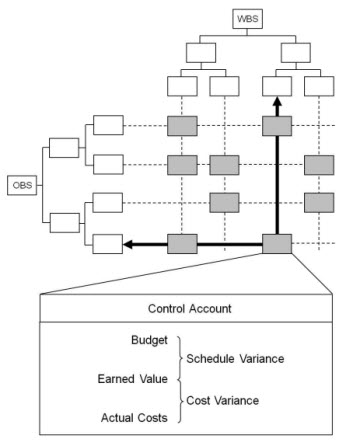
Summarizing EVM data by WBS or OBS
As needed, the CAM or others can drill down from the control account level into the detail data analysis to identify the root cause of a variance, determine the impact of the variance on future work effort, and identify correction actions. The use of the EVM data analysis indices is a common practice to help managers consider their past performance and their future performance to complete the work within the approved EAC and estimated completion date (ECD). This is illustrated below.
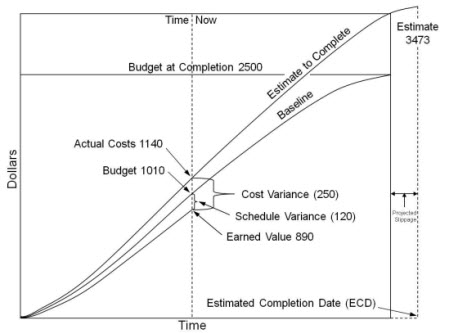
Estimate based on combined cost and schedule performance
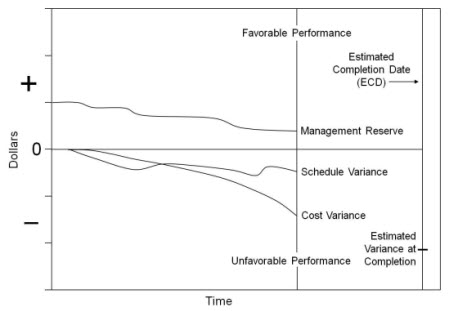
EVM Cost and schedule variance trends
The cost and schedule indices are featured in commercial off the shelf project management toolsets and should be carefully reviewed during each reporting cycle. They serve as a valuable validity test to the estimate at completion.
Revisions and Data Maintenance
The final section is a set of 5 baseline control guidelines that emphasizes disciplined and timely incorporation of customer directed changes, including stop work orders (SWO). The rules also apply to internal replanning and project analysis. Lack of baseline control can doom a project. Establishing and maintaining a schedule and budget baseline is essential to be able to assess work accomplished for each reporting period. The Revision and Data Maintenance section is a must for proactive, meaningful earned value management when there is a constantly changing baseline.
Contractor and Customer Benefits
An earned value management system is an aid to both the EVM contractor and EVM customer. The benefits of implementing an EVMS can be summarized as follows. An EVMS:
- Improves the planning process;
- Fosters a clear definition of the work scope;
- Establishes clear responsibility for work effort;
- Integrates technical, schedule, and cost performance;
- Provides early warning and analysis of potential Earned Value problems;
- Identifies problem areas for immediate and proactive management attention;
- Enables more accurate reporting of cost and schedule impacts of known problems;
- Enhances the ability to assess and integrate technical, schedule, cost, systems analysis, and risk factors;
- Provides consistent and clear communication of progress at all management levels; and
- Improves project visibility and accountability.
| Download this Earned Value EVMS Concepts Article as a PDF document |
